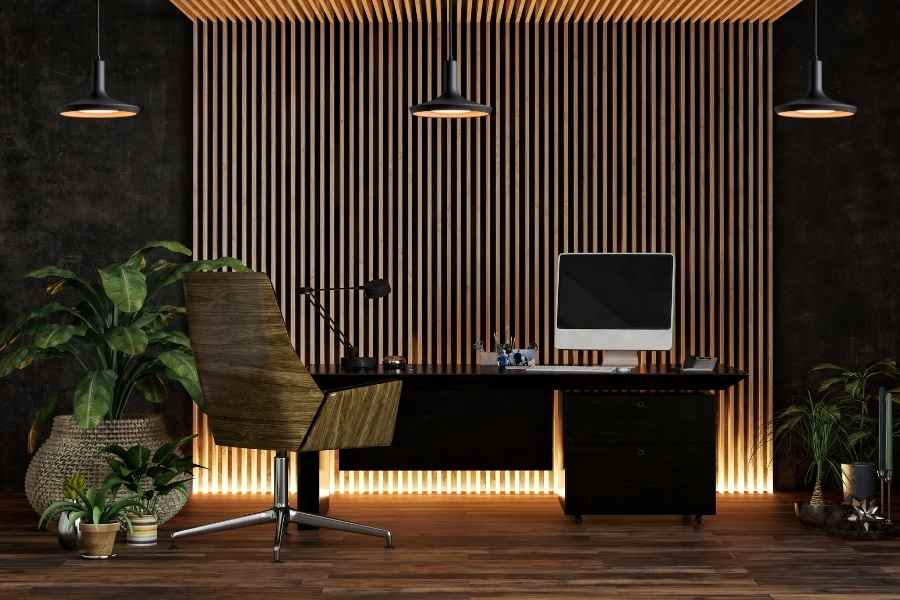Introduction:
Working from home has now become normalised. A good setup matters — and home office lighting, often overlooked, can shape how productive you feel.
Lighting isn’t just about visibility — it’s a key part of your home office setup. The right lighting shapes your mood, productivity, and even how professional you look on video calls.
Whether you’re setting up a small desk nook in a flat or designing a full-sized office, the right balance of light can transform the way you work.
This guide covers office lighting essentials — from ambient to natural light, plus features, placement, and design ideas.
By the end, you’ll know how to create a workspace that’s not just brighter, but healthier and more productive too.
Why Lighting Matters in Your Office or Home Office

Why office lighting matters: it supports focus, eye health, mood, and video calls.
Lighting plays a much bigger role in your workday than you might realise. It’s not just about being able to see your keyboard—your lighting affects how you feel and how well you perform.
Boosts focus and concentration: The right balance of light helps keep your brain alert and reduces distractions, making it easier to stay on task for longer periods.
Reduces eye strain and headaches: Proper lighting minimises glare and prevents you from squinting at your screen, which is a common cause of discomfort during long work sessions.
Improves mood and energy levels: Bright, well-placed lighting stimulates your body’s natural rhythms, helping you feel more energised and positive throughout the day.
Enhances appearance on video calls: Good front-facing light reduces shadows on your face and gives you a professional look, which is especially important for online meetings.
In short, lighting is as important to your home office, desk, computer and chair setup. If you want to stay productive, comfortable, and professional, it’s worth getting right.
Types of Office Lighting You Should Know
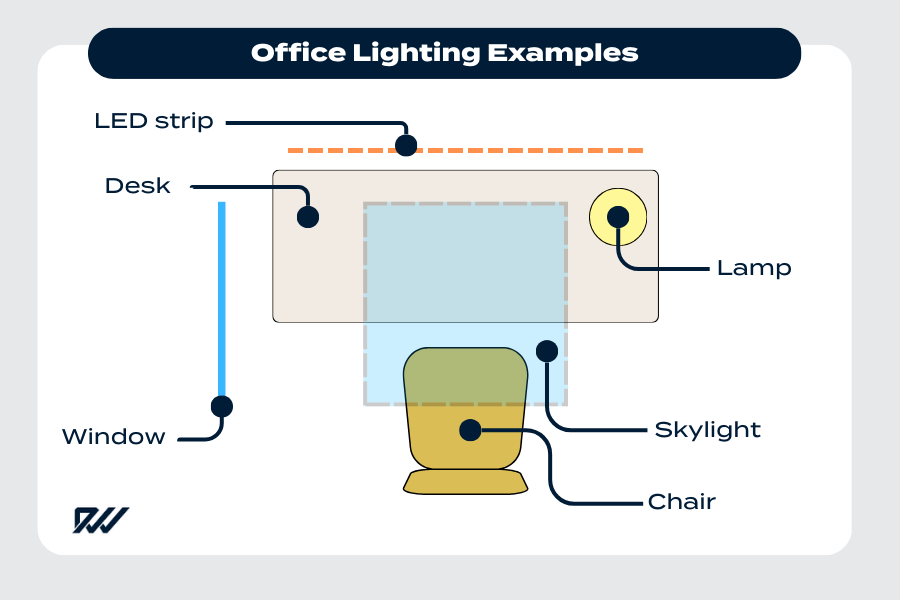
Office lighting example: combine natural light from windows and skylights with lamps and LED strips for a balanced setup.
Not all lighting is created equal. The type of light you use in your home office can dramatically affect how comfortable and productive you feel during the day.
One overhead bulb often makes your space too dim or harsh — not ideal for long hours.
The best workspaces use a mix of ambient, task, accent, and natural light. This layering improves visibility while making your office feel more inviting.
Each light type has a role, and together they create a system that supports your work and wellbeing.
In the next sections, we’ll break down the essentials of home and office lighting.
From ambient glow to desk lamp brightness, each layer builds a healthier, more productive workspace.
Office Ambient Lighting (Your Main Source of Light)
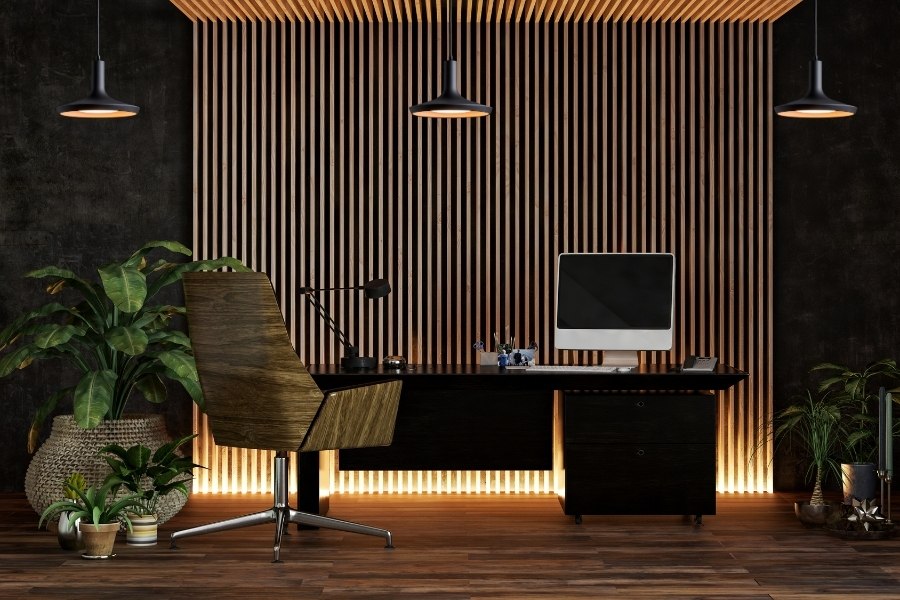
Office ambient lighting with pendant fixtures and accent LEDs creates a modern, balanced home office.
Ambient lighting is your general, overall light source, filling the room with even light, making it easier to move around and carry out everyday tasks. Think of it as the foundation on which all other lighting is built.
- Ceiling fixtures: A classic option that spreads light across the whole room.
- Recessed lighting: Subtle and modern, great for creating a clean, uncluttered look.
- Floor lamps: Flexible and stylish, perfect for adding light in corners or near seating areas.
- Track lighting: Adjustable heads on a track system, letting you direct light where it’s most needed while still providing general coverage.
- Flush-mount or semi-flush ceiling lights: Great for smaller spaces where a low-profile, space-saving option is needed.
- Wall-mounted fixtures (wall washers or sconces): These spread light across walls, reducing shadows and brightening the room evenly.
- Pendant lights: Hanging fixtures that provide both general and decorative lighting, often used above desks or in the centre of the room.
Ambient lighting gives coverage but lacks precision for tasks like typing, reading, or video calls. A dedicated reading lamp or desk lamp can make all the difference by focusing light exactly where you need it.
Layering ambient, task, and accent lighting makes workspaces functional and comfortable.
Office Task Lighting (Focused Work Support)
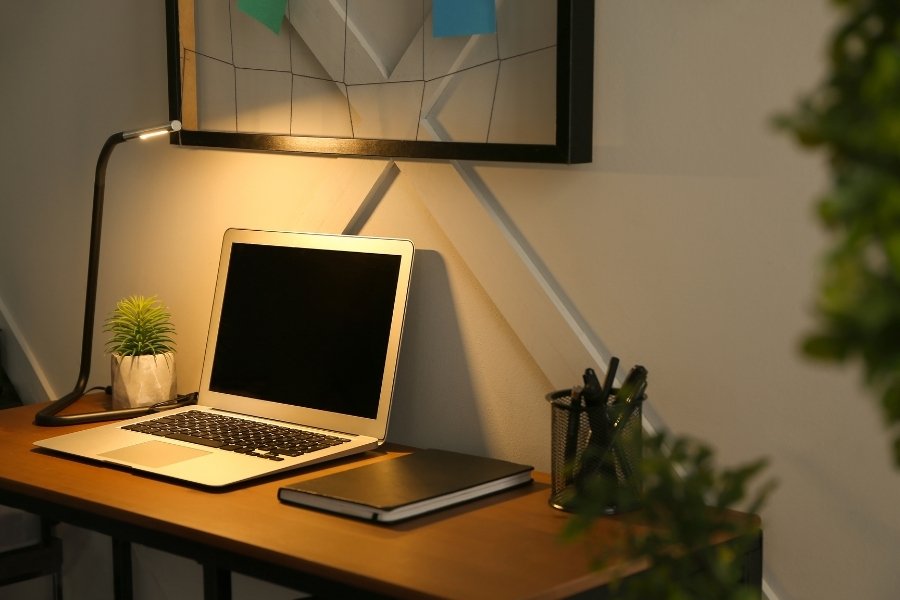
Office task lighting: a slim LED desk lamp provides focused light for productive work.
Task lighting keeps you focused on jobs like reading, typing, sketching, or video calls. It provides focused illumination exactly where you need it, making detailed work easier and reducing strain on your eyes.
- Desk lamps: The most common choice, offering direct light for paperwork, computer use, or hobbies. Adjustable arms and dimming features make them especially versatile.
- Monitor light bars: Slim fixtures that clip onto the top of your screen, reducing glare while illuminating your workspace without taking up desk space.
- Under-cabinet lighting: A clever option if your desk sits beneath shelving, providing bright, shadow-free light directly over your work area.
Task lighting reduces shadows and glare, easing strain during long work hours. A high-quality desk lamp with adjustable brightness and angle remains one of the best options.
Office Accent Lighting (Style & Atmosphere)

Office accent lighting: wall sconces and LED strips create a warm, inviting workspace.
Accent lighting is about creating depth and atmosphere. Unlike task or ambient lighting, it’s less about practicality and more about aesthetics, helping to soften your workspace and make it feel more personal.
- Wall sconces: Mounted to the wall, these add a warm glow and can double as a design feature, perfect for breaking up blank wall space.
- LED strips: Flexible and modern, they can be tucked behind shelves, under desks, or around monitors to create a stylish halo effect.
- Decorative table lamps: Ideal for adding character to your office, while also giving off a cosy and welcoming light.
Adding accent lights makes your office feel more inviting and less clinical, which is especially important if you spend long hours there.
They also allow you to adapt your workspace for different moods—bright and energising during work hours, softer and calming in the evenings.
Office Natural Light (The Unsung Hero)

Office natural light: large windows brighten the workspace, boosting mood and productivity.
Don’t underestimate daylight—it’s the healthiest, most mood-boosting form of light available.
Natural light boosts focus, mood, and well-being. It’s one of the most powerful tools for creating a healthier workspace.
It’s free, abundant, and can completely change the atmosphere of your home office when used well.
- Position your desk near a window: This gives you the benefit of direct daylight while also providing a view, which can reduce stress and refresh your mind during breaks.
- Use blinds or diffusers to soften harsh rays: Too much sunlight can create glare on screens or cast sharp shadows. Simple adjustments like sheer curtains or adjustable blinds help keep the light comfortable and even.
- Incorporate skylights where possible: Skylights flood a room with natural light from above, creating a bright, open feel without taking up wall space. They’re especially useful in loft conversions or home offices with limited windows.
- Balance daylight with artificial lighting: Natural light changes throughout the day, so pairing it with ambient or task lighting ensures you always have the right level of brightness.
Natural light boosts energy and supports your body’s circadian rhythm for better sleep and wakefulness.
Using daylight from windows or skylights sets you up for healthier days and more restful nights.
Must-Have Features in Home Office Lighting
Shopping for lamps can be overwhelming with so many options. Focus on features that boost comfort and productivity, not just style or price.
- Adjustable brightness (dimmable): Gives you control over light levels, whether you need a bright setup for detailed work or a softer glow for late evenings. For most home offices, aim for fixtures that provide 1,500–3,000 lumens in total, with the ability to dim down when needed.
- Colour temperature control: The ability to switch between warm and cool tones lets you adapt your workspace throughout the day. Warm light (2,700K–3,500K) is cosy and relaxing, perfect for winding down, while cooler light (4,000K–5,000K) is closer to daylight and helps keep you alert and focused during work.
- Glare-free designs: Lights with diffusers, matte finishes, or clever positioning prevent harsh reflections and eye strain, which is essential during long hours at your desk.
- Smart lighting integration: Connect your lights to apps, timers, or voice assistants to adjust settings effortlessly, and even create schedules that automatically match your working hours.
- Energy efficiency (LEDs): LED bulbs are the best choice for home offices. They use up to 80% less energy than traditional bulbs, last for years, and are available in a wide range of brightness and colour options.
Quick Comparison: Warm vs Cool Lighting
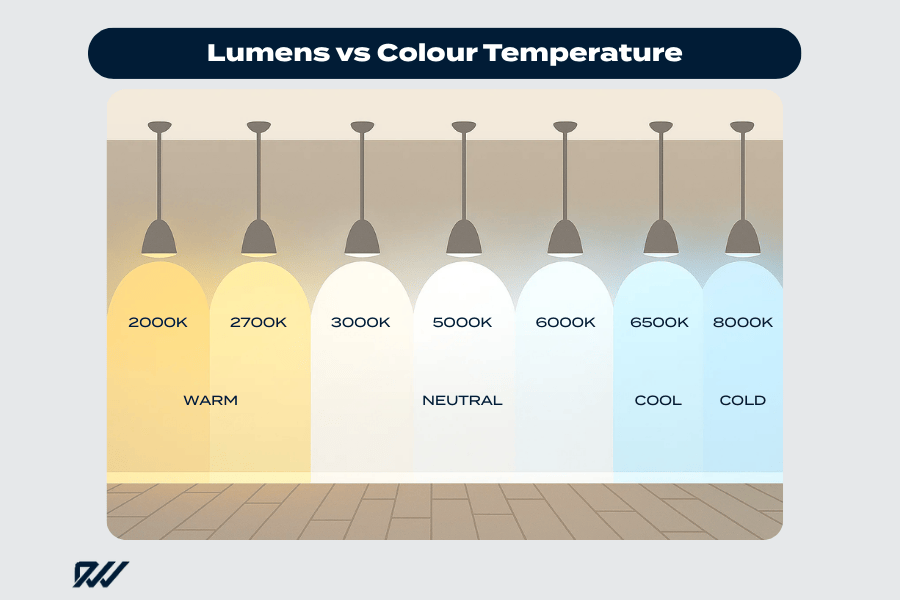
| Feature | Warm Light (2,700K–3,500K) | Cool Light (4,000K–5,000K) |
| Tone | Soft, cosy, relaxing | Bright, crisp, energising |
| Best For | Evenings, creative work, relaxation | Daytime tasks, focus, productivity |
| Mood Effect | Calming, reduces stress | Boosts alertness and concentration |
| Appearance on Camera | Softer, flattering glow | Clearer, sharper image |
Quick Comparison: LED vs Halogen vs Fluorescent
| Feature | LED Bulbs | Halogen Bulbs | Fluorescent Bulbs |
| Energy Efficiency | Very efficient (up to 80% less energy than halogen) | Least efficient, high energy use | Moderate efficiency, but less than LED |
| Lifespan | Long (10,000–25,000 hours) | Short (1,000–2,000 hours) | Medium (7,000–15,000 hours) |
| Light Quality | Wide range (warm to cool options available) | Bright, warm light but limited range | Bright but can feel harsh or cold |
| Cost Over Time | Saves money in the long run | Expensive due to frequent replacement | Cheaper upfront, but less durable |
| Best For | Home offices, long daily use, eco-conscious users | Occasional accent lighting | Garages, workshops, or budget setups |
By focusing on these features, you’ll create a lighting setup that’s not only comfortable and functional today but also flexible, efficient, and future-proof for years to come. And if you’re budgeting your workspace upgrades, our guide on home office setup costs can help you plan your spending wisely.
Best Lighting Ideas for Different Office Setups
Every workspace is unique, and there’s no one-size-fits-all solution when it comes to lighting.
The type of office you have—whether it’s a dedicated study, a converted spare room, or just a desk tucked into the corner of your living space—will shape the choices you make.
In a compact flat, space is limited, so your lighting should be practical and unobtrusive to avoid adding clutter.
Wall-mounted fixtures, clip-on lamps, or slimline desk lights can provide focused illumination without cluttering up valuable surface area.
In larger rooms, you can layer ceiling lights, floor lamps, and accents for a complete setup.
Tailor your lighting to the size of your space and the way you use it. A writer may need bright, focused task lighting, while a designer might benefit from adjustable colour temperature.
Match lighting to your workflow and layout to make your office shine.
Small Home Office or Desk Nooks
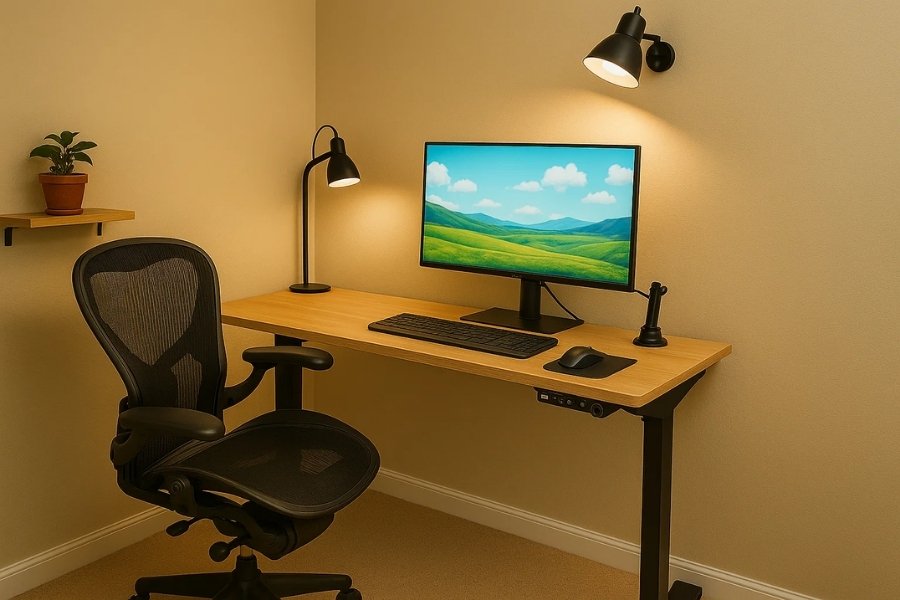
Small home office lighting: desk and wall lamps brighten a compact workspace for comfort and productivity.
If your workspace is on the smaller side—perhaps a desk tucked into a bedroom, living room, or hallway—you’ll need to be smart about lighting.
The goal is to make the area bright and functional without taking up precious space. Compact solutions that can be mounted, clipped, or integrated are ideal because they maximise surface area while still keeping your desk well-lit.
- Clip-on lamps: Lightweight and portable, these can attach directly to your desk or shelving, giving you bright, targeted light without using up surface space.
- Wall-mounted lights: A great option for tiny offices where every inch counts. They keep your desk clear and can be angled to reduce glare.
- Daylight bulbs: These mimic natural light, helping you stay energised and alert, especially if your nook doesn’t get much sunlight.
- Slim LED desk lamps: Modern designs with a small footprint that fit neatly into tight spaces while still providing adjustable brightness.
- Under-shelf or under-cabinet lighting: Perfect if you’ve got shelving above your desk, as it casts direct light downward without needing an extra lamp.
- Multi-purpose lighting: Lamps with built-in USB ports or wireless charging pads are great for small setups, cutting down on clutter while serving more than one purpose.
With small offices or desk nooks, the key is efficiency. Choose attachable or multi-use lights to keep your space uncluttered yet practical.
Even the smallest home office can feel like a productive hub with the right lighting choices.
Large or Shared Office Spacing
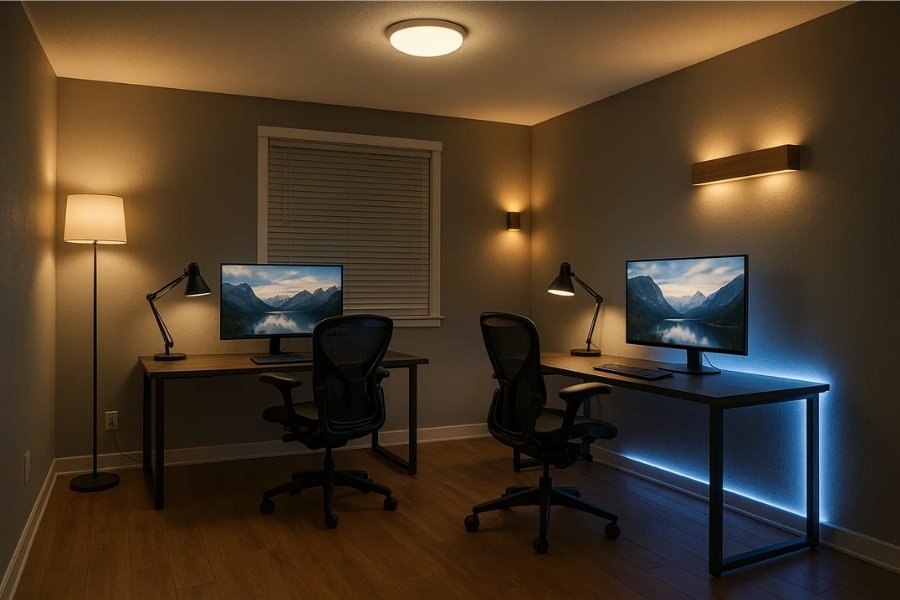
Large or shared office lighting: combine floor lamps, desk lamps, sconces, and LEDs for balanced coverage.
When you’re working in a larger home office—or sharing a space with someone else—lighting needs to do more than just illuminate your desk.
Bigger rooms often have uneven light distribution, which can leave dark corners or overly bright spots.
The solution is to use a combination of fixtures that spread light evenly while also offering flexibility for individual workstations.
- Layered lighting systems: Combining ambient, task, and accent lighting ensures the entire room is evenly lit while still allowing for specific zones to be highlighted.
- Floor lamps for corners: Tall, free-standing lamps are perfect for filling shadowy areas, adding both brightness and a touch of style to larger spaces.
- Pendant fixtures for coverage: Hanging lights provide strong ambient illumination and work especially well in the centre of the room or above a shared table.
- Track lighting: Adjustable heads let you direct light exactly where it’s needed, which is ideal for multifunctional spaces or offices used by more than one person.
- Wall-mounted sconces: Useful for spreading light across larger walls, preventing the space from feeling closed-in or unevenly lit.
With bigger spaces, the key is balance. Layer lights to avoid dark spots and create a comfortable, balanced space.
This approach also works well if your office doubles up as a guest room, study, or shared family workspace.
Video Call & Zoom-Friendly Lighting

Video call lighting: a ring light beside your monitor creates a clear, professional look on Zoom.
In today’s world, online meetings are part of daily life, so having good lighting for video calls is essential.
Poor lighting can make you appear shadowy, tired, or unprofessional on screen, while the right setup ensures you look clear, confident, and camera-ready.
The goal is to create even, flattering light that highlights your face without causing glare or harsh shadows.
- Ring lights: A popular choice for video calls, they provide soft, even illumination directly on your face. Compact desk versions are perfect if you have limited space.
- LED panels: These produce a broader wash of light than ring lights and can often be adjusted for brightness and colour temperature, giving you more control over your appearance.
- Adjustable desk lamps: When positioned correctly, a simple desk lamp with a flexible arm can act as effective video call lighting. Aim it slightly off to the side to avoid glare on your glasses or screen.
- Monitor light bars: Originally designed to reduce screen glare, some models also double as excellent front-facing lights for video calls.
- Portable clip-on lights: Handy for laptops, these small LED lights attach to the top of your screen, making them ideal for those who travel or work in multiple locations.
When it comes to video calls, positioning is just as important as the light itself. Keep your light source in front for an evenly lit face.
With a thoughtful setup, you’ll come across as professional and approachable on every call, whether it’s a team meeting or an important client presentation.
How to Place Lighting in Your Home Office
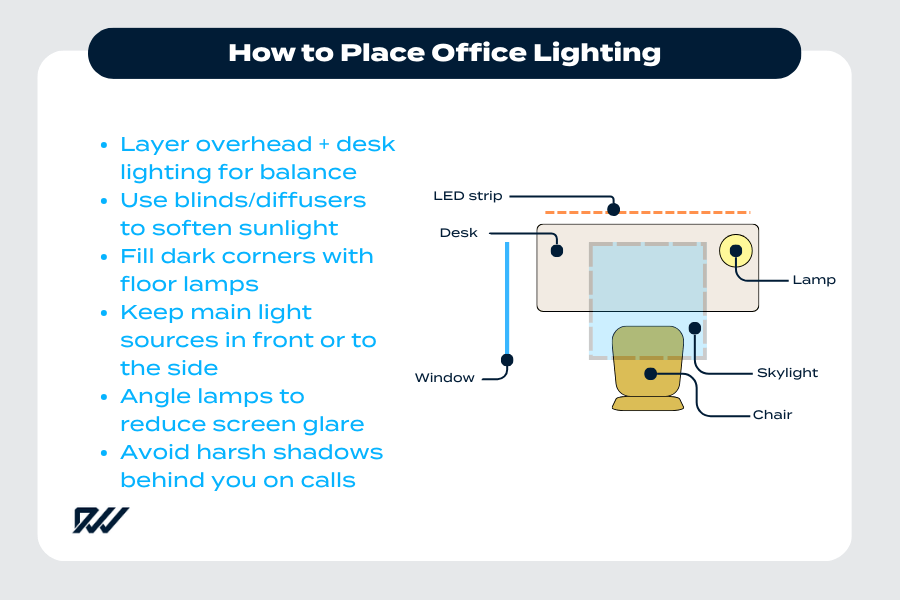
How to place office lighting: combine desk, lamp, window, and skylight placement for balance and comfort.
Choosing the right lamps and bulbs is only half the job. Lighting placement is as important as the lights themselves.
Poor placement can lead to glare, shadows, or uneven brightness, while thoughtful positioning makes your workspace feel comfortable, balanced, and professional.
- Avoid backlighting: If the strongest light source is behind you, your screen will be harder to see, and on video calls you’ll appear as a silhouette. Keep main lights in front or slightly to the side.
- Use front or side lighting for focus: Place task lights so that they illuminate your work area without bouncing directly off your monitor. If you’re right-handed, position desk lamps to your left (and vice versa) to avoid casting shadows.
- Balance overhead with desk lighting: A single ceiling light often creates harsh contrasts. Layer it with a desk lamp or floor lamp to soften the effect and make the space more evenly lit.
- Take advantage of natural light: Position your desk perpendicular to a window whenever possible. This way you benefit from daylight without direct glare on your screen. Use skylights for daylight, balancing with blinds or diffusers when sunlight is too harsh.
- Eliminate dark corners: Large or oddly shaped rooms often end up with patches of shadow. Filling these areas with a floor lamp or wall-mounted light helps the space feel brighter and more open.
- Think about camera angles: For video calls, always place lighting in front of you, never behind. A soft desk lamp, ring light, or LED panel can make all the difference to how professional you look on screen.
Getting lighting placement right doesn’t need to be complicated. Small tweaks — like moving a lamp or monitor — can boost comfort, focus, and video call presence.
Step by Step to Setting Up Office Lighting
Getting your lighting right doesn’t have to be complicated. Follow these simple steps to create a workspace that’s bright, comfortable, and designed for productivity:
- Start with ambient lighting: Choose a ceiling fixture, recessed light, or floor lamp to provide an even base layer of illumination across your office.
- Add focused task lighting: Position a desk lamp, monitor light bar, or under-shelf light to brighten the area where you work most. For the best results, combine this with an ergonomic desk set up that keeps your posture comfortable and your screen at the right height.
- Incorporate natural light: Place your desk near a window or beneath a skylight, but angle it to avoid direct glare on your screen. Use blinds or diffusers to soften harsh sunlight.
- Layer in accent lighting: Add wall sconces, LED strips, or decorative lamps to create warmth, depth, and personality in your office.
- Check placement and balance: Sit at your desk and adjust lights until your workspace feels evenly lit, glare-free, and comfortable for both work and video calls.
With these steps, you’ll move from a poorly lit corner to a well-designed office that supports your health, focus, and professional image.
Design & Style Inspiration
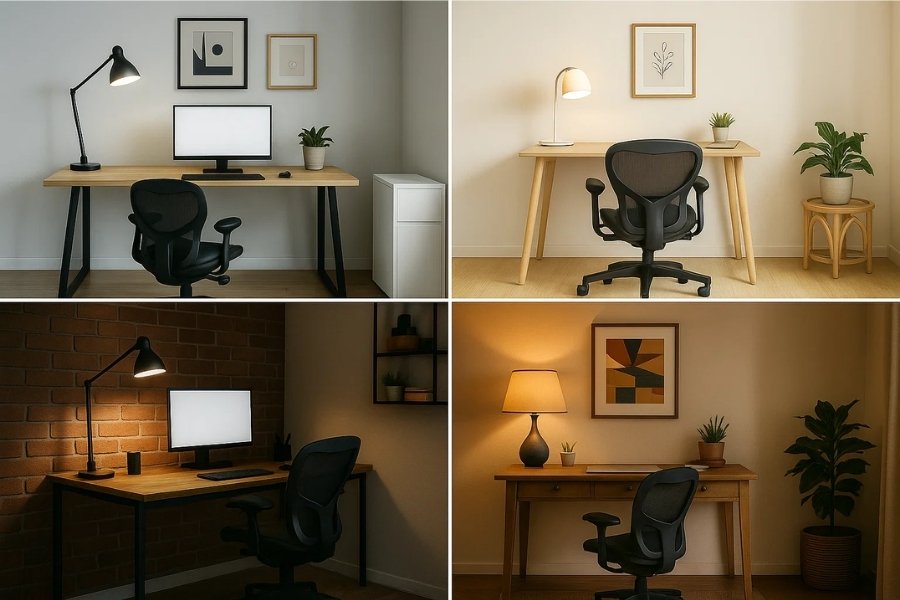
Small home office lighting: four desk setups showing how lamps can brighten compact workspaces.
Lighting isn’t only about function—it’s also a powerful design element that sets the mood and personality of your home office.
The right choice of fixtures, finishes, and styles can tie your workspace into the rest of your home décor while still giving you the practicality you need for work. Whether you prefer something sleek and modern or warm and cosy, there are plenty of options to explore.
- Modern minimalism: Think slim LED light strips, clean lines, and monochrome finishes. These fixtures are understated yet effective, perfect if you like a clutter-free, contemporary workspace.
- Scandinavian simplicity: Combining natural wood, soft fabrics, and warm white bulbs, this style creates a calm and welcoming office. It works well in small spaces where you want a balance between light and comfort.
- Industrial chic: Exposed bulbs, metal shades, and bold geometric shapes bring a raw, stylish edge to your office. This is a great choice if you want your workspace to double as a creative studio.
- Warm and cosy: Lamps with fabric or frosted glass shades cast a softer glow that makes your office feel inviting, especially if you work into the evenings. Pairing this with accent lighting adds layers of warmth.
- Eclectic character: Mix and match different lamp styles and colours to create a space that feels personal and inspiring. This approach works well if you’re aiming for a creative, non-traditional office setup.
The best design is the one that reflects your personality and supports the way you work. By blending practicality with style, your office can become more than just a place to tick off tasks—it can be a space where you feel motivated, comfortable, and inspired every day.
Health & Productivity Benefits of Proper Office Lighting
Good lighting does much more than simply help you see—it directly affects how you feel and perform throughout the day.
Poorly lit workspaces can leave you feeling drained, tense, and unfocused, while a well-lit environment can lift your energy and help you get more done with less strain.
In many ways, investing in the right lighting is an investment in your health and long-term productivity.
- Reduces fatigue and eye strain: Working in dim light forces your eyes to work harder, leading to tiredness, headaches, and blurred vision. Proper lighting helps you stay comfortable even during long sessions at your desk.
- Supports your circadian rhythm: Exposure to the right kind of light during the day helps regulate your body’s internal clock, keeping your sleep-wake cycle balanced and improving rest at night.
- Improves focus and workflow: Bright, well-placed lighting keeps your mind alert and makes it easier to concentrate on complex tasks without constant breaks.
- Boosts mental well-being: Natural or well-balanced artificial light can improve your mood, reduce feelings of stress, and create a more positive working environment.
- Encourages better posture: By reducing the need to squint or lean forward to see properly, well-positioned lighting helps you maintain a healthier sitting position and avoid slouching.
Given how many hours you spend at your desk, it’s easy to see why lighting matters. The right mix of brightness and comfort boosts productivity and protects long-term health.
Quick Tips for Choosing the Right Lighting
If you’re short on time and just want the essentials, here’s a handy checklist to guide your decisions. Think of these tips as quick wins that can make a big difference without overcomplicating things.
- Layer ambient, task, and accent lighting: Combining different types of light ensures your office feels balanced. Ambient lighting gives you overall coverage, task lighting helps you focus, and accent lighting adds warmth and personality.
- Opt for LEDs to save energy: LED bulbs use far less electricity than traditional bulbs, last much longer, and are available in a wide range of brightness and colour tones. They’re the most cost-effective option in the long run.
- Choose adjustable brightness settings: Being able to dim or brighten your light means you can adapt to the time of day, your workload, or even your mood. It’s a simple feature that greatly improves comfort.
- Position your desk to maximise natural light: If possible, set up near a window or beneath a skylight. Natural daylight boosts mood and helps regulate your body’s internal clock, making you feel more alert.
- Match your lighting style to your décor: A workspace that looks good feels better to work in. Whether you prefer modern minimalism or warm and cosy tones, pick lighting that complements your space.
- Think about flexibility: Portable lamps, clip-on lights, or smart bulbs that can be controlled with an app make it easy to adapt your setup as your needs change.
Follow these tips to build a brighter, healthier, more enjoyable home office. Small lighting tweaks can greatly boost productivity and comfort.
Final Thoughts: Creating the Perfectly Lit Workspace
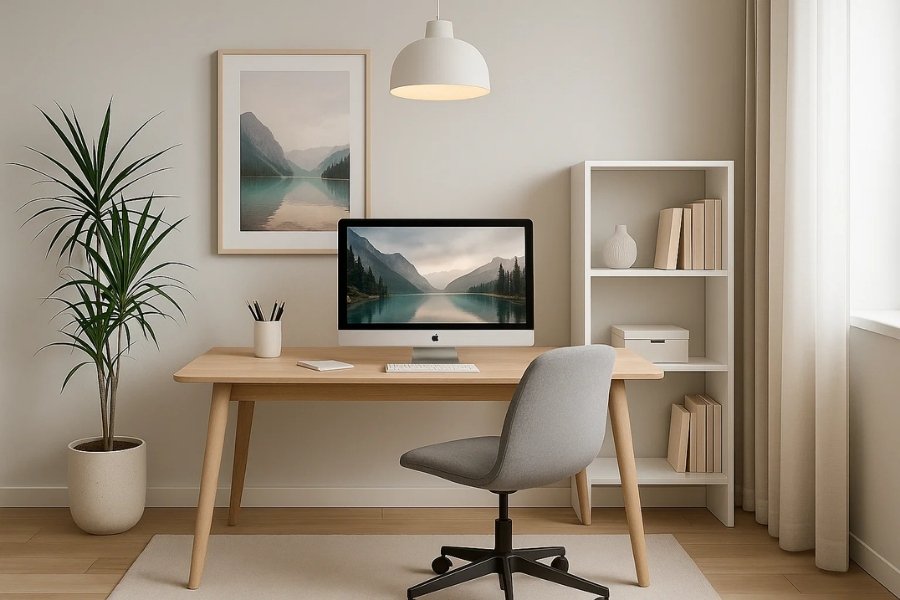
Office ambient lighting: a pendant lamp and natural light create a bright, minimalist workspace.
Home office lighting is about more than just adding a lamp—it’s about building an environment that supports your work, your health, and your style.
By layering different types of light, choosing features that suit your needs, and tailoring placement to your space, you’ll have an office that feels both productive and comfortable.
The right office lighting can:
- Boost focus and reduce eye strain
- Improve your mood and energy levels
- Enhance your professional presence on video calls
- Reflect your personal style and make your workspace inspiring
There’s no perfect setup — it depends on your space, tasks, and preferences. Start small by adjusting placement or adding one new lamp, then build from there.
Think of lighting as an investment in your well-being and career. Thoughtful changes can transform your home office into a space where you thrive daily.
